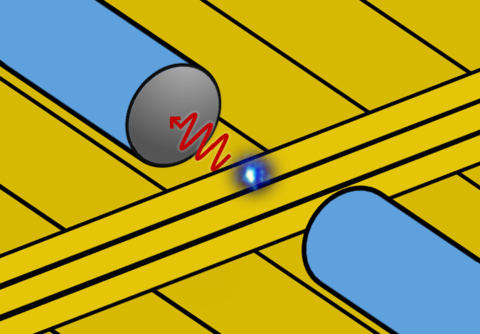Summary
Quantum networks, a promising resource for computing and sensing, generate useful entanglement between locations separated by geographic distances. Our research is focused on generating high-fidelity remote entanglement between trapped ion qubits using telecom photons. The key enabling step is using an ion-trap-integrated fiber Fabry-Pérot cavity for efficient entanglement generation between ions and telecom photons.
Description

The goal of a quantum network is to establish entanglement as a resource between distant locations. Shared entanglement over long distances may enable distributed quantum computing, quantum-enhanced long-baseline interferometry, the transmission of complex quantum states, or a variety of other applications. Long-range classical networks use repeaters, which amplify transmitted signals to enable them to propagate over geographic distances despite the inevitable losses in optical fiber or electrical wires. This solution cannot be used for quantum networks, since quantum states cannot be copied or amplified. Instead, entanglement can be generated over shorter distances (such that losses are not too high) between nodes of a quantum network. Extending the range of such a network requires multiple nodes connected in series, along with the technique of entanglement swapping. If node B shares entanglement with two other nodes A and C on either side, local quantum operations at node B can be used to "swap" the A-B and B-C entanglement for A-C entanglement, thus increasing the distance over which entanglement is shared and realizing a "quantum repeater".
This method requires quantum repeater nodes that are capable of establishing long-range entanglement with another node, and that can preserve and manipulate local multi-qubit quantum states within the node as needed for entanglement swapping. Optical photons, especially those near 1550 nm wavelength where losses in optical fiber are minimized, are ideal carriers of quantum information ("flying qubits") over long distances. A 1550 nm photon can travel 10-15 km through optical fiber, corresponding to a transit time of 50-75 μs, with a 50% survival probability at the output. Because photon loss makes it challenging to maintain quantum coherence for longer durations in an all-optical system, we are building quantum network nodes that use trapped ions as "stationary qubits", and coupling them to the flying qubits that enable long-range entanglement. Trapped ions make excellent stationary qubits, as they exhibit long coherence times, can be individually controlled and read out with very high fidelity, and can be entangled with other trapped ion qubits to perform entanglement swapping or general quantum algorithms. The challenge is to create an efficient, high-fidelity interface between the quantum state encoded in a trapped ion and the quantum state of a traveling 1550 nm photon. Our work builds on pioneering efforts from many other groups performing short-range remote entanglement of trapped ion qubits (Maryland, Oxford, Duke, ...), demonstrating entanglement between ions and telecom photons (Innsbruck, Saarbrücken, ...), and coupling ions or atoms to fiber Fabry-Pérot cavities (Innsbruck, Sussex, Oxford, ENS, Bonn, MPQ, ...).
This project is focused on creating long distance entanglement between trapped ion qubits in separate quantum network nodes using 1550 nm photons as flying qubits. Each node contains a high-finesse fiber Fabry-Pérot cavity integrated into a surface-electrode ion trap to generate high-fidelity, high-rate entanglement between Ca+ ions and 854 nm photons, which are then coherently converted to 1550 nm photons by difference frequency generation. These 1550 nm photons are used as long-distance information carriers, and Bell state measurements of 1550 nm photons from separate network nodes can be used to generate heralded remote entanglement between the ion qubits in those nodes.
PERSONNEL
Permanent staff: Lindsay Sonderhouse, Dietrich Leibfried, Daniel Slichter
Postdocs:
Graduate students: Margie Bruff, Katie David

